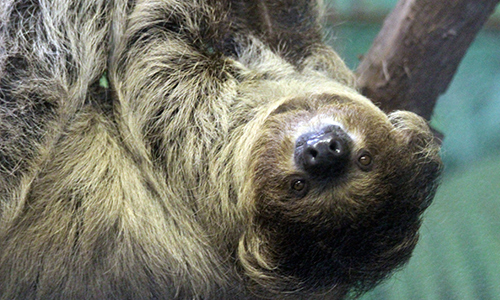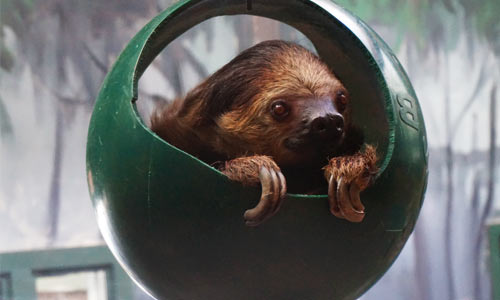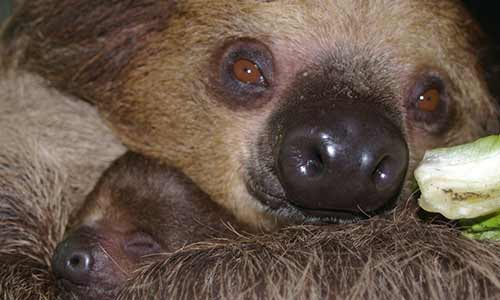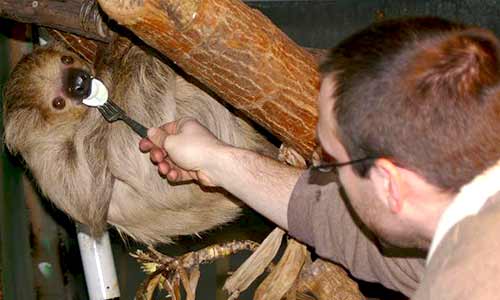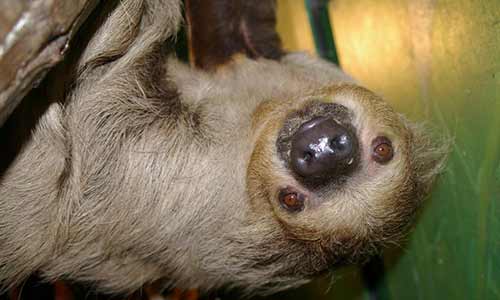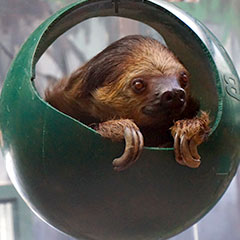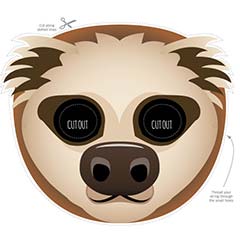Appearance:
In size and shape, the sloth can be compared to a small dog. These tree-dwelling herbivores have relatively flat faces with a short, dark snout. Their front legs are longer than their rear legs, but all four are long and thin, making them very adept at hanging. As its name “two-toed sloth” suggests, its front limbs have--you guessed it-- two toes. However, like all species of sloths, its rear limb has three toes. All four of its feet have very calloused pads. Sloths are also covered in two layers of thick hair. The outer layer can be about 6 inches long and provides a perfect, moist environment for the growth of many organisms. Their hair actually grows in the opposite direction of most mammals because sloths spend the majority of their lives upside-down!
They're born with a set of hollow molars used for grinding food, and these teeth have the ability to grow continuously throughout the sloth’s life. Due to sloths' flattened faces, short snouts, and lack of teeth in the front of their mouths, they use their hardened lips to grasp and tear vegetation. They have relatively poor hearing and vision, but their keen sense of smell helps them find food. Although the front legs are longer than the back, the sloth’s long, thin limbs are designed for climbing and hanging. At the end of their toes are 3- to 4-inch curved claws that are useful in climbing, gathering food, and for defense.
Size:
Weight: 6.8 to 17.6 pounds
Length: 50 to 70 centimeters
Diet:
Sloths are omnivores, but eat mostly vegetation, preferring buds, tender shoots and leaves. They may also opportunistically eat animal matter in the form of insects, eggs, nestlings, and small vertebrates. Extremely low rates of metabolism allow sloths to survive on relatively little food. Some research suggests that it may even take up to a month for food to fully digest!
Reproduction:
Sloths are generally solitary and adults pair solely in order to mate. Breeding occurs year-round. The gestation period is five to six months, and there is typically a single offspring born per litter. Mothers give birth upside-down in the trees, and babies immediately seek the shelter of her chest for protection and to begin nursing. The young nurse for one month and during that time “inherit” a preference for certain foods from their mother. This specialization of diet is thought to minimize competition with other sloths in the same forest. Babies are 10 inches in length and weigh 12 ounces when born. They cling to their mother's belly for five weeks until they have the strength to move on their own. The young leave their mother after nine months. Females reach sexual maturity in three years and males at four to five years.
Behavior:
Groups of female sloths sometimes occupy the same tree, and young may inherit the home range of their parents. Sloths receive their common name from the slow-paced lifestyle that they lead. Their average climbing speed is only 6 to 8 feet per minute. Sloths are extremely cautious. They're unable to support their own body weight in order to walk on the ground and, as a result, rarely leave the trees. Sloths spend most of their life hanging upside-down from tree branches, whether sleeping, eating, mating, or giving birth. They come to the ground only about once a week to urinate and defecate, or to change trees for a new food source. When on the ground, they're forced to drag themselves forward, using their clawed forelimbs. Luckily, they're able to swim and will enter water to cross a river or to cool off. Sloths are good swimmers, having a streamlined body and fur that has evolved for wet, tropical weather.
Primarily nocturnal, sloths sleep 15 to 18 hours a day. Their average body temperature can vary approximately 10 degrees daily.
When threatened, sloths use hissing vocalizations, and they may dangle from their back limbs and swipe at threats with their forepaws.
Habitat/Range:
Found in the tropical moist lowland and montane forests. Sloths range through Venezuela (the delta and south of the Río Orinoco) and the Guianas (French Guiana, Guyana, and Suriname) south into Brazil (Maranhão state west along the Rio Amazonas/Solimões) and west into the upper Amazon Basin of Ecuador and Peru. The sloth's southern limit in the western Amazon of Brazil is unclear. It occurs in the southern departments of Colombia, with its northern limit being the departments of Meta and Guainí.
Median Life Expectancy:
In the wild: 20 years
In captivity: about 30 - 40 years
Predators:
Jaguars, ocelots and humans
Fun Facts:
- The sloth is the world's slowest mammal
- Sloths move so slowly that their hair is the perfect habitat for algae to grow. Algae give sloths a green tint and provides camouflage among the trees.
- Sloths are most closely related to armadillos, anteaters and pangolins



